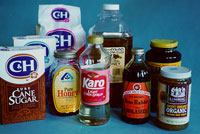Sweeteners in Foods
 The word sugar is a collective term used in the food industry. Although a food product does not bear the term sugar on its list of ingredients, it may still contain sugar. Several other names of sugars include fructose (fruit sugar), sucrose (table sugar), dextrose, levulose, lactose (milk sugar), invert sugar, molasses, brown sugar, honey and maltose.
The word sugar is a collective term used in the food industry. Although a food product does not bear the term sugar on its list of ingredients, it may still contain sugar. Several other names of sugars include fructose (fruit sugar), sucrose (table sugar), dextrose, levulose, lactose (milk sugar), invert sugar, molasses, brown sugar, honey and maltose.
Sucrose is the ideal sweetener for several reasons:
- It acts as a bulking agent or filler to increase the volume and viscosity of a food product and as a carrier for trace ingredients;
- its large particle size enables it to disperse ingredients such as colors and flavors and assist in wetting and dispersion when water is added;
- and when mixed with fat, enables the incorporation of air into the mixture, such as in the product of cakes.
What Influences Sweetness
Sweetness is a sensory phenomenon influenced by environmental, psychological and physiological factors. The intensity of the sweetness depends on temperature, concentration and acidity. Sucrose also improves the flavors of many foods by creating a balance between acidity, bitterness and saltiness.
Functionality of Sucrose
 At low levels, sucrose is an excellent substrate for the growth of microorganisms. The most important fermentation in which sucrose is used is in the production of alcohol. In the process of fermentation, sucrose is inverted to glucose and fructose. In the production of wine, sucrose is sometimes added when the natural sugar content of the grape juice is too low. Sucrose is also added to increase fermentation in yogurt and bread dough.
At low levels, sucrose is an excellent substrate for the growth of microorganisms. The most important fermentation in which sucrose is used is in the production of alcohol. In the process of fermentation, sucrose is inverted to glucose and fructose. In the production of wine, sucrose is sometimes added when the natural sugar content of the grape juice is too low. Sucrose is also added to increase fermentation in yogurt and bread dough.
Sucrose is practical in the sense that at high concentrations it binds water, which makes the water unavailable for microbial growth. Sugar is often used as a preservative in foods because of the high osmotic pressure generated by sugar solutions. Sucrose is used as a preservative in canning, fruit preservation and in meat curing. Not only does sucrose affect the water activity of fruit products, it also influences enzyme activity, carbonyl-amine reactions and fat oxidation.
Sugar Substitutes
When choosing an alternative sweetener to replace sucrose and/or glucose as ingredients in a food or beverage, certain properties should be considered:
- The sweetener should have similar body and texture without any aftertaste.
- The alternative sweetener should perform the same functions as the sucrose or glucose in the product.
- The sugar replacement should undergo different physiological and nutritional metabolism in the gastrointestinal tract and biochemical changes in the mouth.
Nutrient content claims may appear on the front of side panel of some food labels. These claims are strictly defined by the Food and Drug Administration. Here are the claims approved for sugar.
| Nutrient Content Claim | Definition (per serving) |
| Sugar-free | Less than 0.5 gram sugars |
| Reduced sugar or less sugar | At least 25% less sugars* |
| No added sugar | No sugars added during processing or packing, including ingredients that contain sugars, such as juice or dry fruit. |
* Compared to the reference, or regular, food this would replace.
Non-nutritive Sweeteners
These sweeteners are not metabolized by the body. Because they do not contribute calories or energy to the diet, they are appropriate in the diets of those on calorie restricting diets, such as persons with some types of diabetes and those who are overweight. Non-nutritive sweeteners also work well in preventing dental caries.
Here are the non-nutritive sweeteners approved by the Food and Drug Administration (FDA) for use in food and/or drinks:
- Aspartame
- Acesulfame-K
- Neotame
- Saccharin
- Sucralose
Nutritive Sweeteners
Nutritive sweeteners include any sweeteners that contribute calories or food energy and are metabolizable. The group of nutritive sweeteners includes sugars, syrups, molasses, sugar alcohols or polyols, and honey.
Many factors must be considered when choosing polyols. One must consider caloric content, regulatory status, relative sweetness, stability, cost and cooling effect.
Polyols can be found in fruits and vegetables, but their concentrations are far too low to be extracted commercially, so a process of hydrogenation has been developed. Polyols are less sweet than sucrose and need an intense sweetener to improve the sweetness level. They also do not exhibit browning through Maillard type reactions.
Here are the commonly used nutritive sweeteners:
- High Fructose Corn Syrup
- Honey
- Sorbitol
- Mannitol
- Xylitol
- Lactitol
- Maltitol
- Isomalt
- Lycasin
